The trees in my neighbourhood
Module 3 - Trees and stress
Download the module 3 [PDF 2.20 MB]
Summary
Students discover the influence of the environment on tree development, and the diseases that can affect it.
After identifying different stresses and establishing their relationship with tree physiology, students head outdoors to diagnose trees along the street.
In a discussion session, they debate the question of whether the diseased trees should be cut down, treated or left on their own.
Cross-curricular competencies
- CCC1 - Use information
- CCC3 â Exercise critical judgment
- CCC9 - Communicate appropriately
Subject area competencies
- SAC1 - Seek answers or solutions to scientific or technological problems: define a problem, choose an investigation or design scenario, carry out the procedure, conduct an experiment, analyze the results or solution
- SAC2 â Make the most of knowledge of science and technology: understand how technical objects work, understand natural phenomena
- SAC3 - Communicate in the languages used in science and technology: participate in exchanging scientific and technological information, divulge scientific or technological knowledge or results, interpret and produce scientific and technological messages
Objectives
- Identify the relationships between the environment and tree growth
- Learn to diagnose the state of health of trees
Contents
- Diversity of life: habitat, physical and behavioral adaptation
- Life-sustaining processes: photosynthesis and respiration
- General characteristics of the Earth: water
- Geological and geophysical phenomena: water cycle
Classroom organization
- As a group, individually and in teams of 2 or 3 students
- Duration: one class session of 45 minutes, one session of 60 minutes outdoors and one class session of 30 minutes
Sequence of activities for Module 3
- Activity 1: Trees under influence - 45 minutes â in class
From ten illustrations, students learn to identify the stresses to which a tree can be subjected and find out about the phenomenon of tree decay. They fill out the Experiment 1 worksheet to consolidate their knowledge of the signs of environmental influences on the tree.
 - Activity 2: The tree in its environment - 60 minutes â outdoors
Students head outdoors to diagnose trees along the street. They note their observations on the Experiment 2 worksheet and consolidate what they have learned.
 - Activity 3: The value of a tree - 30 minutes â in class
After identifying diseased or damaged trees, students debate the fate of the diseased trees they observed (cut them down, treat them or do nothing).
Â
Activity 1 - Trees under influence
Teacher Activity
Summary
From ten illustrations, students learn to identify the stresses to which a tree can be subjected and find out about the phenomenon of tree decay.
They fill out the Experiment 1 worksheet to consolidate their knowledge of the signs of environmental influences on the tree.
Classroom organization
45 minutes in class â individually and as a group
Material required
| Worksheet title | Contents | Quantity/User |
|---|---|---|
| Visual aids 1 to 10 | Illustrations of stressed trees | 1 series - teacher |
| Concepts | Influence of the environment on trees and stress | 1 teacher |
| Answer key 1 | Answers to Experiment 1 worksheet | 1 teacher |
| Experiment 1 | Questionnaire on tree stress | 1 per student |
Step-by-step procedures
- Remind students that while trees have an impact on the environment, the contrary is equally true. Introduce the concept of stress (see the Concept worksheet and the Answer key 1 worksheet). Distribute the Experiment 1 worksheet and answer question 1.
 - Review the main principles of tree physiology (phytosynthesis, evapotranspiration, respiration) using the Concept worksheet.
 - Answer question 2 of the Experiment 1 worksheet.
 - Explain that stresses cause tree dieback, and define this phenomenon. Answer question 3.
 - A tree weakened by a stress is more vulnerable to diseases. Explain that trees also have cavities (decay), although this is caused by fungi and not by bacteria, as is the case in humans. Explain that a tree defends itself by producing antifungal substances and a specialized scar tissue called callus tissue. Complete questions 4 and 5 with the students.
 - Introduce the concept of an entry point for decay: an injury or structural defect, a weak point through which fungi can penetrate the wood. Answer question 6.
 - Present the ten illustrations of trees that have been subjected to a stress (Visual aid worksheets 1 to 10). Ask students whether these trees seem healthy and whether they observe signs that something is wrong. Start a debate on the possible sources of stresses and on which aspect of tree physiology or morphology these stresses can have an impact. For each image, fill out the chart in question 7 of the Experiment 1 worksheet.
 - In conclusion, summarize the concepts covered during the activity.
Activity 2 - The tree in its environment
Teacher Activity
Summary
Students head outdoors to diagnose trees along the street. They note their observations on the Experiment 2 worksheet and consolidate what they have learned.
Classroom organization
60 minutes outdoors â in teams of 2 or 3 students
Material required
| Worksheet title | Contents | Quantity/User |
|---|---|---|
| Visual aids 1 to 10 | Illustrations of stressed trees | 1 series - teacher |
| Concepts | Influence of the environment on trees and stress | 1 teacher |
| Answer key 2 | Answers to Experiment 2 worksheet | 1 teacher |
| Tool | Identification key (see Module 1) | 1 teacher and 1 per team |
| Experiment 2 | Observations of the stress of trees along the street | 1 per team |
Preparation
45 minutes
Prepare the route students will follow. Choose primarily trees showing signs of stress. Number the trees to be identified and observed (a dozen) by placing a numbered card at the base of each. Identify the genus and the stresses of each tree and note the answers.
Step-by-step procedures
- Outdoors, divide the class into teams and explain the route to follow.
 - Review the concept of tree stress by presenting the 10 visual aid worksheets. Distribute the Experiment 2 worksheet and the Tool worksheet.
 - Ask students to identify the genus as well as apparent stresses of each trees, and to note this beside the appropriate tree number on their worksheets. Ask students to specify whether it is a mild or major stress.
 - At the end of the activity, collect the worksheets and announce that the class will debate the fate of the diseased trees they observed (cut them down, treat them or not intervene) â Activity 3.

Activity 3 - The value of a tree
Teacher Activity
Summary
Students use the observations and data collected in Activities 1 and 2. They calculate the average diameter of trees,
and then evaluate the quantity of carbon stored.
By comparing the results obtained at the two locations studied, they realize the impact of trees on different
environmental factors.
Classroom organization
30 to 75 minutes in class â in teams of 4 or 5 students + 15-minute homework assignment
Material required
| Worksheet title | Content | Quantity/User |
|---|---|---|
| Concepts | Influence of the environment on trees and stress | 1 teacher |
| Answer key 2 | Answers to Experiment 2 worksheet | 1 teacher |
| Experiment 2 | Observations of the stress of trees along the street â completed worksheet | 1 per team |
Step-by-step procedures
- Divide the class up into the same teams and distribute the Experiment 2 worksheets they filled out in Activity 2. Summarize what transpired during Activity 2 outdoors.
 - Assess the progress of each team and provide the correct answers, reviewing the strategy to be used. Review the concepts related to the consequences of each stress.
 - Ask each team to sum up their ideas on the fate of the diseased trees they observed (cut them down, treat them or do nothing).
 - Start a group discussion on the various answers and ask students to justify their views:
   == What grounds justify your choice?
 - In conclusion, talk about the value of trees (financial value, legacy, etc.) and the importance for arboriculturists (specialists of trees), landscape architects and others of diagnosing the state of health of trees.

Teacher Visual aid 1 to 10
Trees and stress - Images
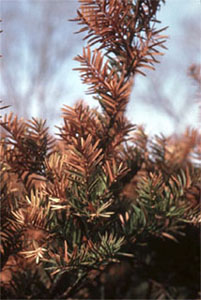 Image 1: Tree with dried and discolored leaves (observable sign) caused by drought (stress factor)
Image 1: Tree with dried and discolored leaves (observable sign) caused by drought (stress factor)
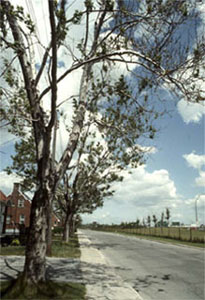 Image 2a and 2b: Tree with fewer leaves, some yellowed (observable sign) caused by atmospheric or urban pollution (de-icing salt, carbon dioxyde, dust, etc.) (stress factor)
Image 2a and 2b: Tree with fewer leaves, some yellowed (observable sign) caused by atmospheric or urban pollution (de-icing salt, carbon dioxyde, dust, etc.) (stress factor)
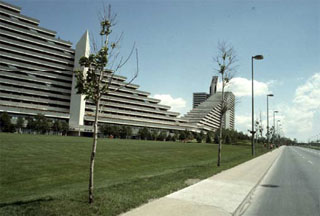
 Images 3a and 3b: Trees presenting carpophores (observable sign) caused by decay (stress factor)
Images 3a and 3b: Trees presenting carpophores (observable sign) caused by decay (stress factor)

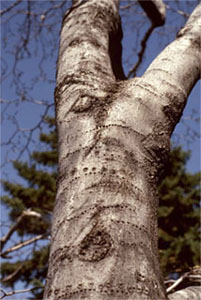 Image 4: Tree with visible signs of damages (observable sign) caused by wildlife, in this case by a woodpecker (stress factor)
Image 4: Tree with visible signs of damages (observable sign) caused by wildlife, in this case by a woodpecker (stress factor)
 Image 5: Tree with chewed leaves (observable sign) caused by insects (stress factor)
Image 5: Tree with chewed leaves (observable sign) caused by insects (stress factor)
 Image 6: Trees with chlorosis, more or less pronounced discoloration of the leaves, due to a lack of chlorophyll necessary for photosynthesis (observable sign) caused by an alkaline or toxic soil, in which nutrients are not available to the plant (stress factor). Chlorophyll is the pigment that which gives leaves their green color.
Image 6: Trees with chlorosis, more or less pronounced discoloration of the leaves, due to a lack of chlorophyll necessary for photosynthesis (observable sign) caused by an alkaline or toxic soil, in which nutrients are not available to the plant (stress factor). Chlorophyll is the pigment that which gives leaves their green color.
 Image 7: Tree with leaves mottled with black or yellow spots (observable sign) caused by a disease (stress factor).
Image 7: Tree with leaves mottled with black or yellow spots (observable sign) caused by a disease (stress factor).
 Image 8: Trees with broken branches (observable sign) caused by caused by ice or lightning (stress factor).
Image 8: Trees with broken branches (observable sign) caused by caused by ice or lightning (stress factor).
 Image 9: Tree with a gash in the wood (observable sign) caused by a mechanical injury (stress factor)
Image 9: Tree with a gash in the wood (observable sign) caused by a mechanical injury (stress factor)
 Image 10: Tree with an incomplete crown and/or leaning trunk (observable sign) caused by lack of space or light (stress factor)
Image 10: Tree with an incomplete crown and/or leaning trunk (observable sign) caused by lack of space or light (stress factor)
Teacher Concepts
The influence of the environment on trees
Different factors exert a stress on tree growth, sometimes hindering its development. Examples include sunscald, water stress, frost, atmospheric pollution, diseases and injuries.
Stresses disturb physiological processes in the tree, such as photosynthesis, respiration, evapotranspiration and absorption. They can lead to dieback of the tree, a process that weakens branches and stunts leaves, ultimately resulting in the death of the tree.
As dieback progresses, the tree is more sensitive to diseases, in particular to fungi that cause decay. Using enzymes, these microorganisms attack the wood and little by little dig a hole in the trunk, which we call decay. Often the most visible part of the fungus is its fruit, the carpophore. In response to an infection, the tree produces antifungal compounds. The compartmentalization of certain of its anatomical parts blocks the progression of the fungus. The entry point of a decay-causing fungus is usually an injury or a structural defect, a weak point through which fungi can penetrate the wood. The tree defends itself by producing a specialized scar tissue called callus tissue.
For landscape architects, it is very important to diagnose diseased trees before creating a plantation design. A tree surgeon or forest engineer is called in to identify which trees are diseased or damaged. A list is also made of those trees that have a structural defect such as a forked stem following an insect attack on the terminal bud, since they are more likely to break. This presents a danger for users and can constitute an entry point for a decay-causing fungus.
It is also important to consider the positive aspects of a tree, such as its heritage and ecological value. By evaluating the impact related to the state of health of the tree, to its value and to the project, a decision is made to treat or to cut down the tree.
Some definitions
Photosynthesis:
This is the process through which plants use light to manufacture their food and produce energy reserves. This phenomenon relies on a complex molecule, chlorophyll. This pigment, which gives plants their green color, is mainly found in their leaves. Chlorophyll captures light energy and uses it to form carbohydrates from water and carbon dioxide (CO2). Photosynthesis also produces oxygen, which is released into the atmosphere.
View the photosynthesis process.
Respiration:
All living beings (plants, animals and microorganisms) breathe. Respiration makes it possible to obtain energy from carbohydrates. This energy is necessary for living beings to grow, move and ensure all their vital functions. In plants, respiration is the inverse reaction to photosynthesis. Plants consume oxygen (oxidation of sugars) and release water and carbon dioxide (CO2).
Evapotranspiration:
This is the phenomenon by which plants perspire (transpiration by evaporation). In this way, plants lose water as it evaporates into the air.
The warmer the ambient temperature, the more this phenomenon accelerates. In trees, evapotranspiration occurs mainly from the leaves.
To learn more, view the evapotranspiration phenomenon.
For more definitions, view the glossary.

Student - Experiment 1
1. Define what stress is for trees:
2. Using the diagram below name the elements that each of these mechanisms requires in order to be able to contribute to tree growth

Photosynthesis:
Respiration:
Absorption:
Evapotranspiration:
3. Define dieback:
4. Complete the following diagram

See also the trunk layers.
5. What do we call the tissue a tree produces in response to decay?
6. Draw arrows to connect the decay entry points to their cause:
 Holes  |
Ax |
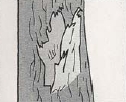 Mechanical injury  |
Birds |
 Forked stem  |
Frost |
 Frost crack  |
Destruction of the terminal bud |
7. For each image presented to you, fill in the following chart, choosing from the list of possible answers:
| Image # | Signs observable on the tree | Stress | Consequences |
|---|---|---|---|
| 1 | Drought | ||
| 2 | Fewer leaves, some yellowed. | The leaves are covered with dust, which prevents the tree from absorbing CO2. | |
| 3 | Carpophore | ||
| 4 | Animals | Wounds may be an entry point for diseases. | |
| 5 | Chewed leaves | ||
| 6 | Alkaline or toxic soil | Roots are not able to absorb nutritive elements â chlorophyll is not produced. | |
| 7 | Diseases | ||
| 8 | Broken branches, incomplete crown broken trunk | Wounds may be an entry point for diseases. The tree a structural problems. The tree may die. | |
| 9 | Mechanical injury | ||
| 10 | Incomplete crown, leaning trunk | The tree experiences growth problems. |
Student - Experiment 2
Using the chart below as a guide, note the stress(es) that can be observed on each tree (if any are present), after having identified its genus:
| Signs observable on the tree | Stress |
|---|---|
| Dried and discolored leaves | Drought |
| Large leaves, some yellowed | Atmospheric pollution |
| Carpophore | Decay |
| Damaged trunk | Animals |
| Chewed leaves | Insects |
| Discolored leaves along the veins | Alkaline or toxic soil |
| Spots on the leaves | Disease |
| Broken branches, incomplete crown, broken trunk | Ice or lightning |
| Gash in the wood | Mechanical injury |
| Incomplete crown, leaning trunk | Lack of space |
| Number | Genus | Observable stress(es) |
|---|---|---|
| Â | Â | Â |
| Â | Â | Â |
| Â | Â | Â |




